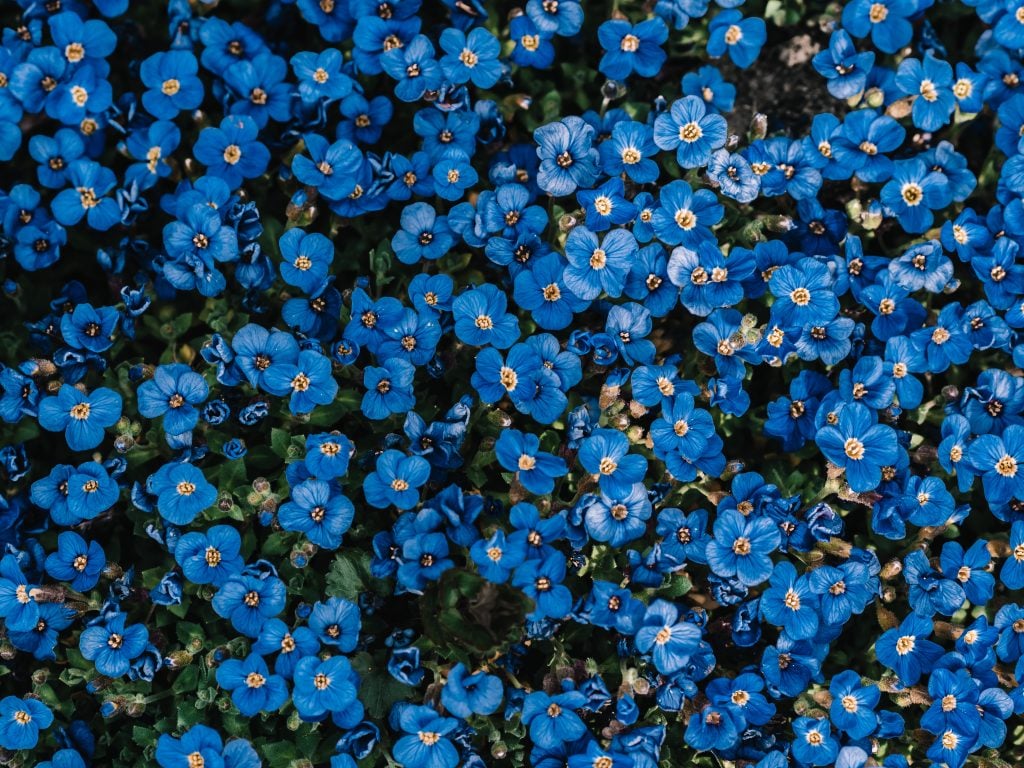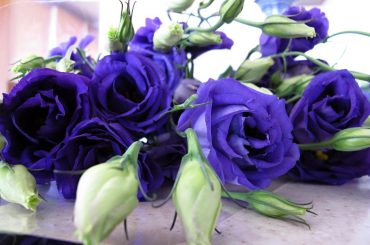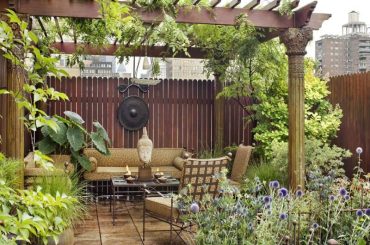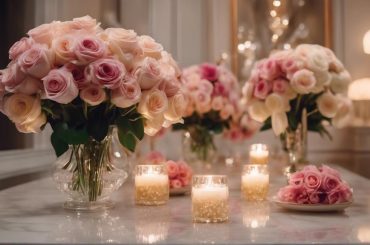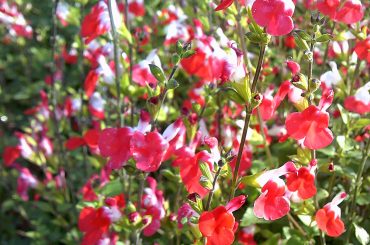Table of Contents
We all can settle on the point that blue flowers give one of the best hues in our gardens, right? They not only add an amazing and unique appeal to our garden but also have numerous medicinal and ornamental uses. If your plan is good and you perform these blue flowers, you will get a blue hue in your garden from the beginning of spring to the end of fall.
Over all these things, blue flowers are comparatively easier to maintain as most of them can survive harsh sun exposure as well as shady zones.
You may come across many options while choosing blue flowers for your garden but choosing any one of them can be a stressful task. In this article, we will come across the best 21 blue flowers that you will crave to have in your garden.
List of 21 Bulbs with Blue Flowers
1. Bluebells
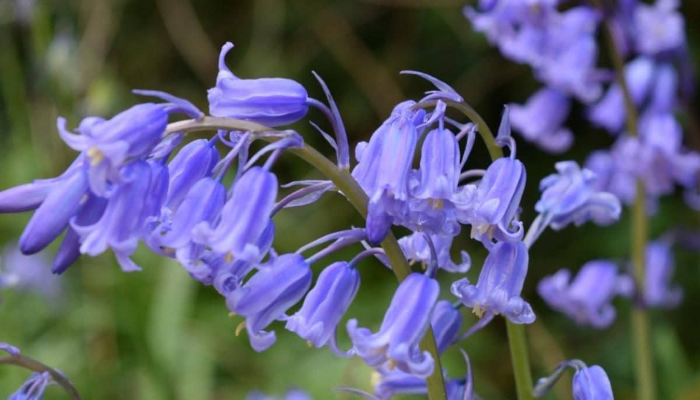
Bluebells specimen are indigenous to Europe and bloom in the season of spring with their vibrant blossoms. They display a preference for growing in soil that is well-drained and abundant in moisture while also being tolerant to exposure to full sun. Optimal growth of these flowers can be achieved by regular watering throughout their growing period.
Scientific name: Hyacinthoides non-scripta
Advantages
- Bluebells’ popularity is mostly due to their sugary fragrance and beautiful appearance.
- Bluebells, with their delicate nature, is considered pivotal ecological maker. Furthermore, they provide a food source to bees and other pollinators, which enhances biodiversity.
2. Delphinium
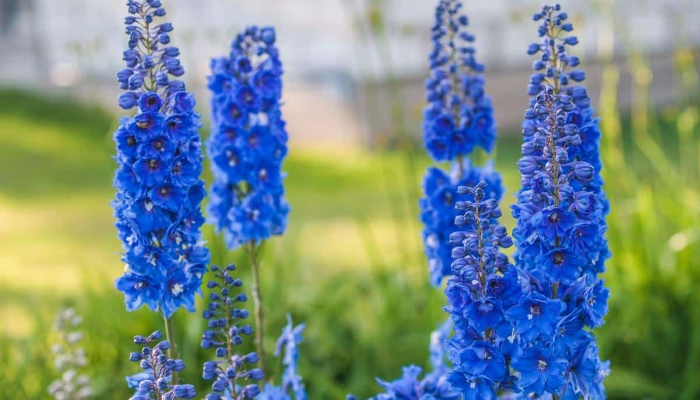
Delphinium is indigenous to Northern Hemisphere and blooms in the season of summer. They require well-draining soil for better growth and need full sun exposure. However, they can survive in partial shade and need moderate hydration.
Scientific name: Delphinium
Advantages
- Delphinium is renowned for having tall height and a range of colours in its various flowers. These are common choices for enhancing the aesthetics of the garden as well as providing special addition to the flower arrangement.
- These flowers, with their captivating beauty, are also known for their ability to draw in hummingbirds (if your ecological environment has them) and sustain the local wildlife population.
3. Blue Poppy
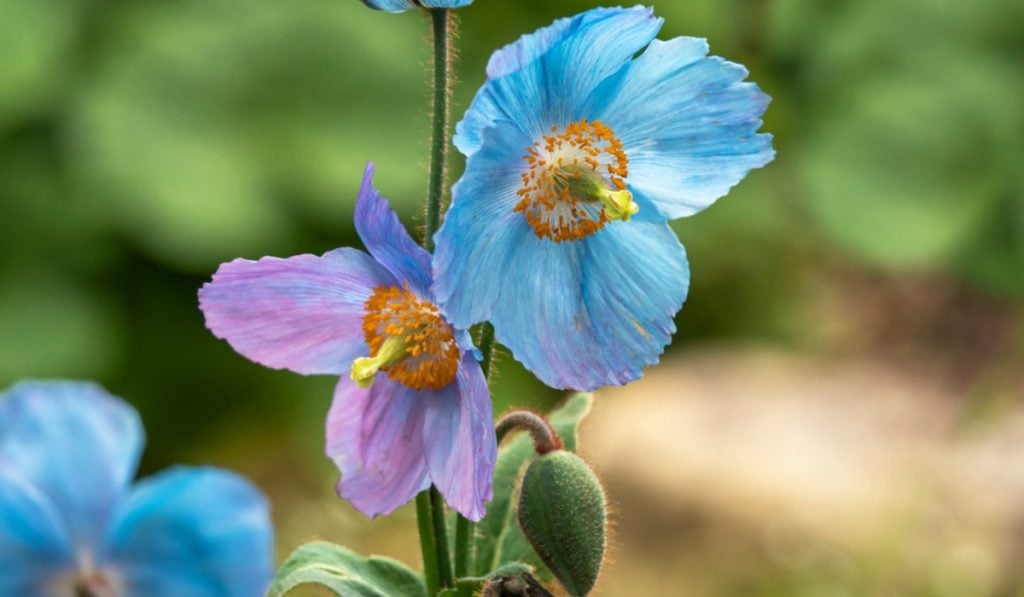
The Blue Poppy is an amazing botanical marvel and is indigenous to the majestic Himalayan range and displays its beauty during the spring season. To thrive, it needs soil that is sufficiently cool, moist, and well-drained while also preferring to bask in partial shade. For this flower to flourish, it needs regular hydration during its growing phase.
Scientific name: Meconopsis betonicifolia
Advantages
- Apart from its aesthetic appeal, the Blue Poppy has been widely recognised in traditional medicine for its numerous health benefits. It has been utilised to treat a diverse range of ailments, such as fever, inflammation, and pain. Furthermore, certain species of the Blue Poppy have been studied for their anti-cancer properties!
4. Grape Hyacinth
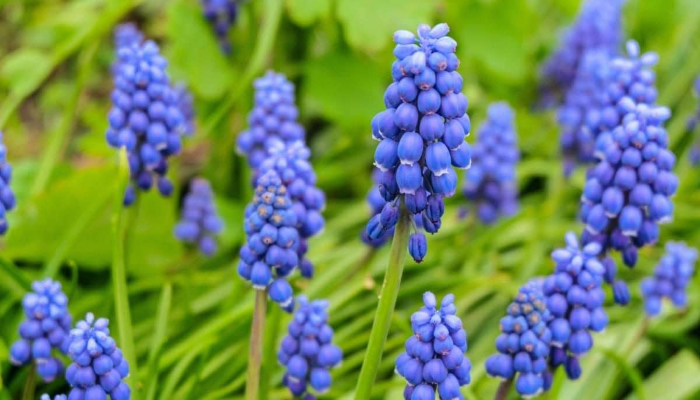
The Grape Hyacinthe is indigenous to the Mediterranean region. They burst into bloom during the spring season. It thrives best in well-draining soil and ideally grows in areas that support full sun. Nevertheless, this flower is adaptable to partial shade too. Moderate watering is important during their growing period.
Scientific name: Hyacinthus muscari
Advantages
- The Grape Hyacinth is known for its fascinating aroma and attractive flower that comes in a variation of blue and purple. This makes them a top pick for ornamental gardening, and their charm is indeed highly prized!
- Furthermore, Grape Hyacinths play a vital role in sustaining the local biodiversity as they attract an array of pollinators, including bees, that aid in fertilisation. Some of their species have been recognised to treat headaches, coughs, and respiratory infections traditionally.
5. Blue Columbine
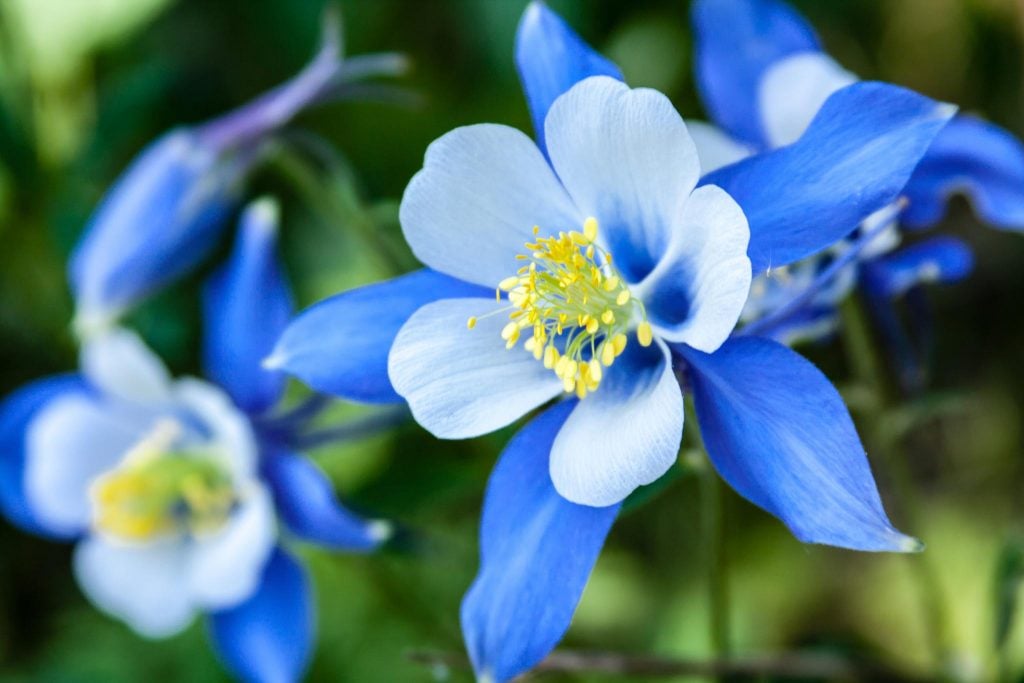
This flower is commonly referred to as Rocky Mountain Columbine. This is native species that primarily thieves in the region of North America. This variety flourishes during the latter part of spring to early summer and favours cultivation in adequately drained soil with limited exposure to sunlight. However, they can sustain full sunlight exposure without any significant damage.
Scientific name: Aquilegia caerulea
Advantages
- The bell-shaped flower of Blue Columbine is valuable as it comes in hues of blue and white, which makes it a favoured selection for gardens and cut flower compositions.
- These blue flowers have major advantages. It not only possesses the capabilities of enticing both bees and hummingbirds to support local wildlife, but also it is known for historical application in traditional medicine as a remedy for fever, migraine, and throat discomfort.
6. Iris
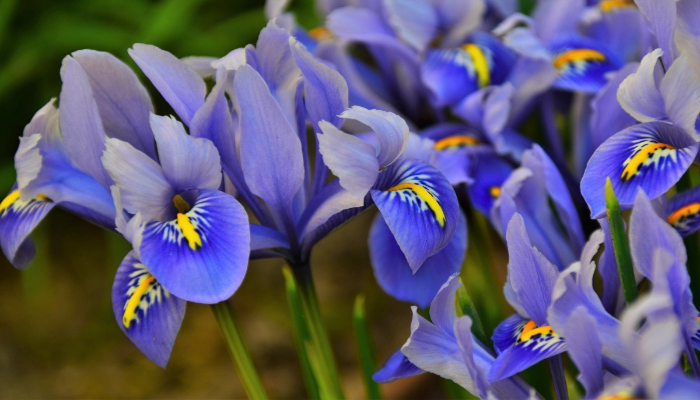
Irises (plural: Iris), which are endemic to various regions worldwide, showcases their vibrant blooms during distinct seasons, with their flowering period spanning from spring to fall, depending on the classification. They thrive best when the soil has good drainage and an adequate amount of direct sunlight.
Scientific name: Iris Germanica
Advantages
- The appeal of Irises lies in their graceful, sword-shaped leaves and their stunning flowers, which can be found in diverse hues.
- Apart from their aesthetic qualities, Irises have been used for medicinal purposes in traditional medicines to treat skin irritations, inflammation and gastrointestinal disorders.
7. Blue Lupine
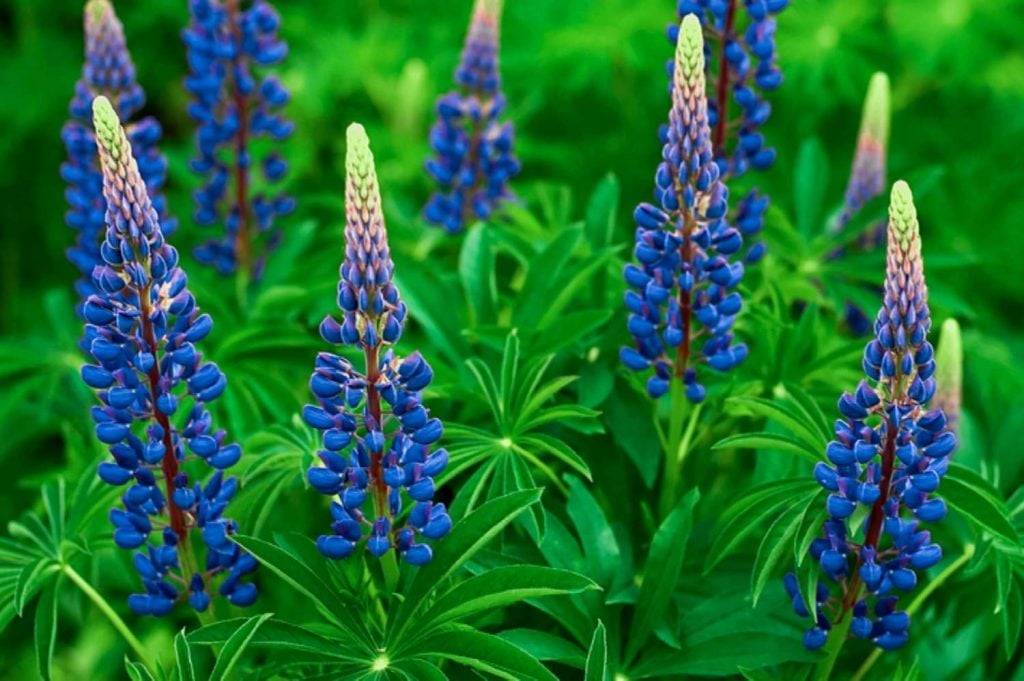
Blue Lupines, which are indigenous to North America, blossom during the late spring to early summer. They flourish when planted in soil that is adequately drained and needs full sunlight. However, they can survive enduring partially shaded regions.
Scientific name: Lupinus Perennis
Advantages
- Beyond its visual appeal, the Blue Lupine has been recognised for its role in attracting bees and other pollinators, which contributes to supporting the local ecosystems. Moreover, some of the species are used in medicines to treat respiratory infections, fever, and digestive disorders.
8. Forget-Me-Not
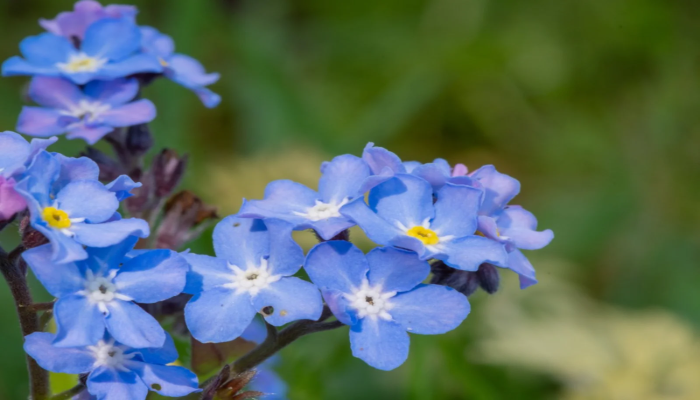
Forget-me-nots hail from Europe blossoms in the early to late spring. It needs well-drained soil with moderate moisture and partial shade, though it can withstand exposure to full sunlight.
Scientific name: Myosotis sylvatica
Advantages
- This small, dainty flower comes in varying colours of blue. It is a much-favoured selection for ground coverage and garden borders.
- Forget-me-nots are acknowledged to attract bees and other important pollinators, serving as a crucial element in sustaining the local ecological system. Like many other blue flowers, it is also used in medicines to treat high fever and respiratory infections.
9. Blue Anemone
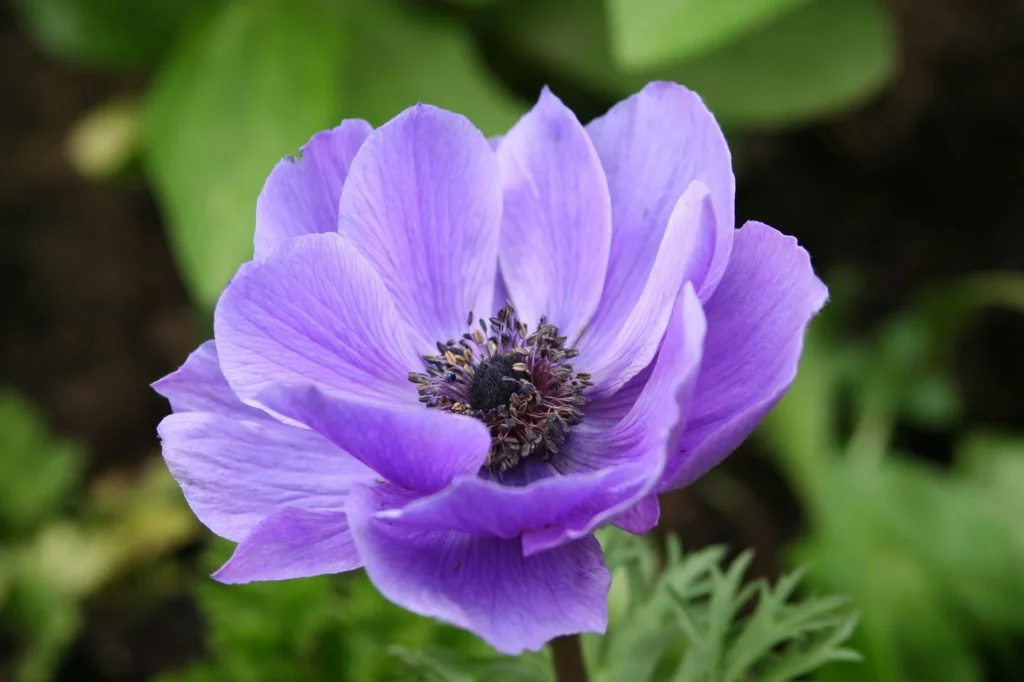
Blue anemones, commonly referred to as Windflowers, originate from Europe and Asia and bloom in the Spring. These flowering plants prefer to grow in soil that is both moist and well-draining. They are capable of surviving in the full and partial sun. However, the latter one suits them the best.
Scientific name: Anemone blanda
Advantages
- They are renowned for their fragile flowers that come in shades of blue and purple. Blue Anemones hold great importance as the preferred selection for garden edges and ground coverage.
- Blue Anemones’ attractive qualities also extend to their ability to draw in bees and provide essential support to the local ecosystem. They also treat diseases such as fever, headaches, and respiratory infections.
10. Ballon Flower
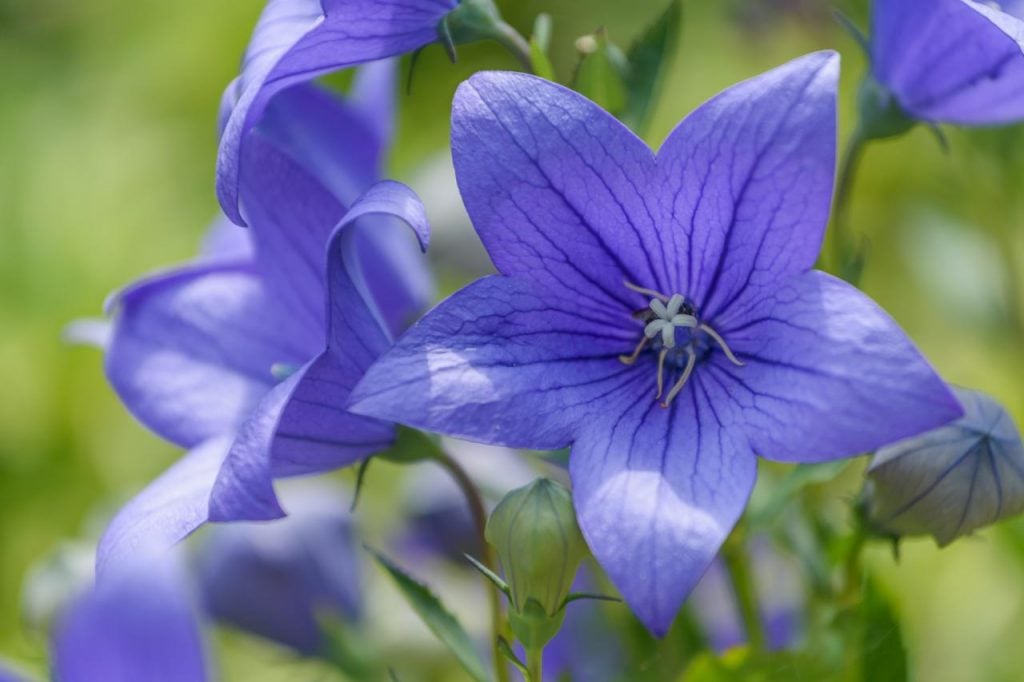
Ballon Flower is indigenous to East Asia and is typically in full blossom during the summer. It is also known as the Chinese Bellflower and is renowned for its unique balloon-shaped buds that unfurl into elegant flowers. They need moderate watering and full sunlight during their growing season.
Scientific name: Platycodon grandiflorus
Advantages
- They are revered for their charming balloon-shaped buds that bloom into amazing star-shaped flowers of blue and purple hues. These flowers are in high demand for garden embellishments.
- Ballon Flowers have an illustration history in traditional medicines and have been used to remedy numerous afflictions such as cough, respiratory, and fevers. Furthermore, research studies have uncovered that it has an anti-inflammatory and anticancer agent.
11. Bachelor’s Button
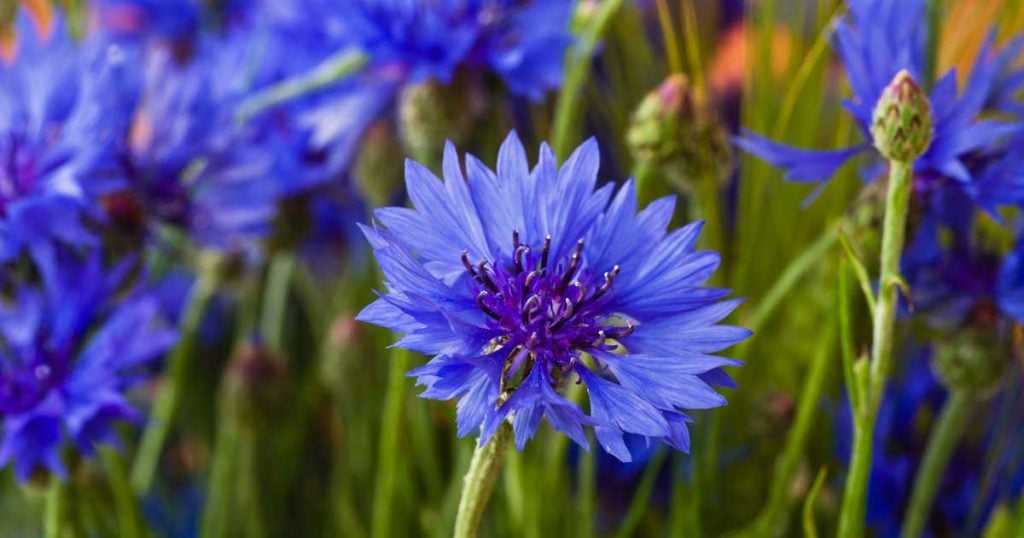
Bachelor’s Button is also referred to as Cornflowers. These flourish in the summertime and are endemic to Europe. These plants thrive best in well-drained soil and have complete exposure to the sun. They need moderate hydration for optimal growth.
Scientific name: Centaurea cyanus
Advantages
- Moreover, these flowers draw in bees and other pollinators, thereby fostering the local ecosystem. Besides ornamental value, they have traditional use in medicines used to treat digestive disorders and fever.
12. Scottish Bluebell
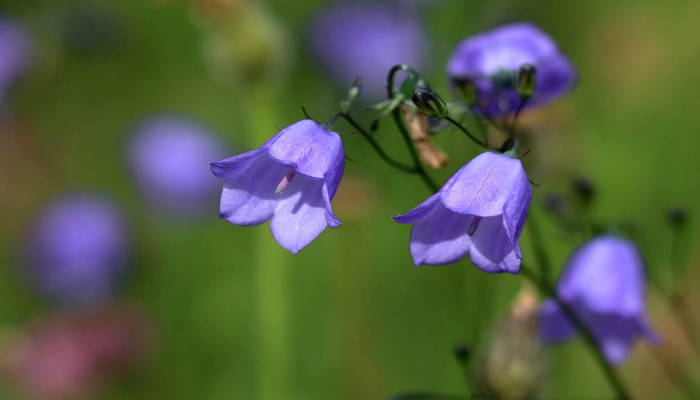
Scottish Bluebells are indigenous to the continent of Europe and typically experience their blooming phase during the summer season. These plants tend to thrive in well-drained soil and have abundant exposure to direct sunlight. They need moderate hydration to flourish.
Scientific name: Campanula Rotundifolia
Advantages
- The Scottish Bluebells are greatly esteemed for their fragile and exquisite bell-shaped flowers that have shades of both blue and purple. That’s why they are frequently selected for rock gardens and utilised as ground covers.
- Another noteworthy characteristic of Scottish Bluebells is their capacity to attract bees and other types of pollinators. They have been used in traditional medicines used for treating respiratory infections, fever, and digestive disorders.
13. Globe Thistle
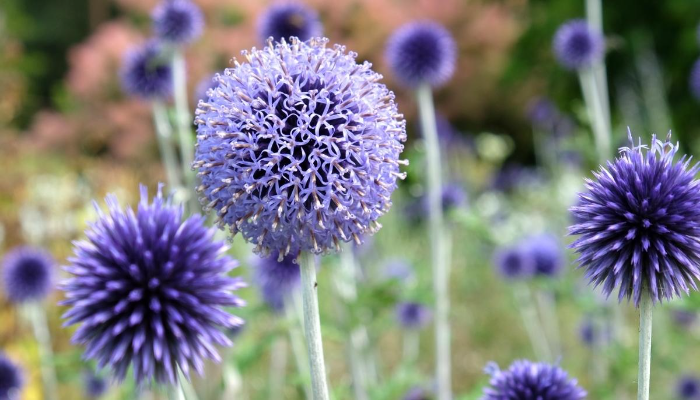
Indigenous to the European continent, Globe Thistle, initiate their blooming phase during the summer and sustain until early fall. For optimal growth, they need well-draining, moist soil and direct sunlight. They also need a moderate level of hydration throughout the day.
Scientific name: Echinops Bannaticus
Advantages
- They have the ability to attract the pollinators such as butterflies, thus playing a pivotal role in supporting and sustaining local ecosystems. They are also used to treat fever, inflammation, and rheumatism.
14. Blue Flax
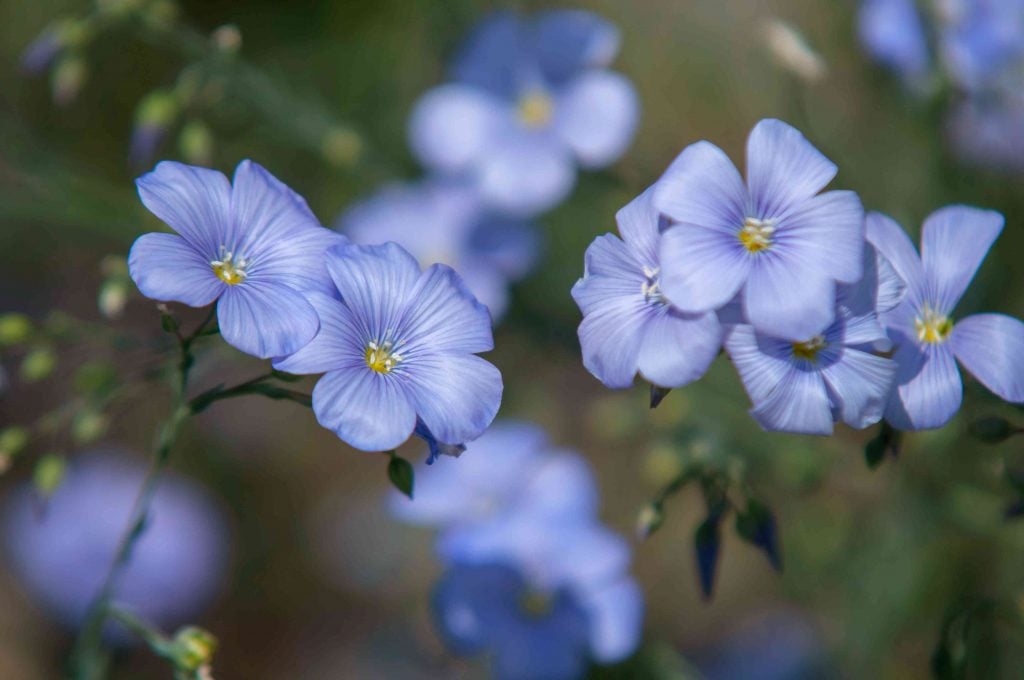
Blue Flax is indigenous to North America. They are also known by the name Prairie Flax. Their blooming takes place in the summer season. These plants thrive when planted in well-draining soil with abundant access to direct sunlight. They also have excellent resilience to drought, so they need minimal watering throughout their growth cycle.
Scientific name: Linum perenne
Advantages
- Blue FLax is held in high popularity because of its intricate sky-blue flowers and slender stems.
- Furthermore, Blue Flax is a valuable botanical addition to any garden as it effectively brings butterflies and bees that play a significant role in maintaining the local ecosystem.
15. Blue-Eyed Grass
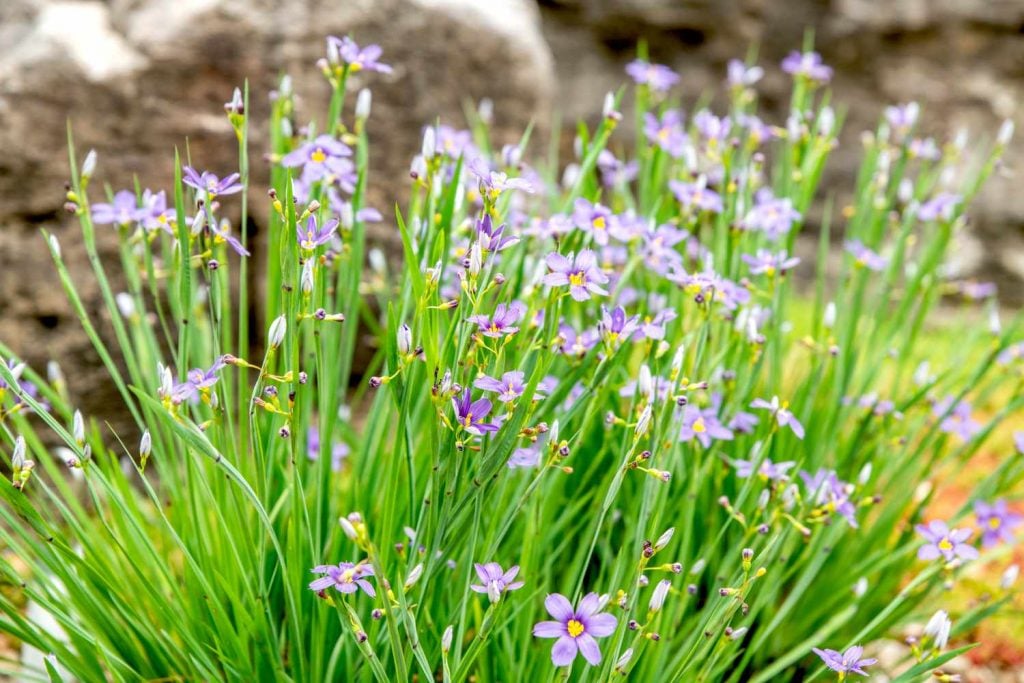
Blue-Eyed Grass is an indigenous flower of North America that produces small, star-shaped blue flowers that flourish in late spring or early summer. They particularly need well-draining soil with a pH range between 6 to 7.5. Additionally, these blue flowers need full sunlight for at least 6 hours a day.
Scientific name: Sisyrinchium bellum
Advantages
- The Blue-eyed Grass is an appealing and easy-to-care wildflower that is frequently utilised in naturalising gardens and meadows to add aesthetic appearance.
- Moreover, this plant plays a crucial role in nourishing pollinators, including bees and butterflies, thereby promoting diversity and sustaining the local ecosystem.
16. Russian Sage
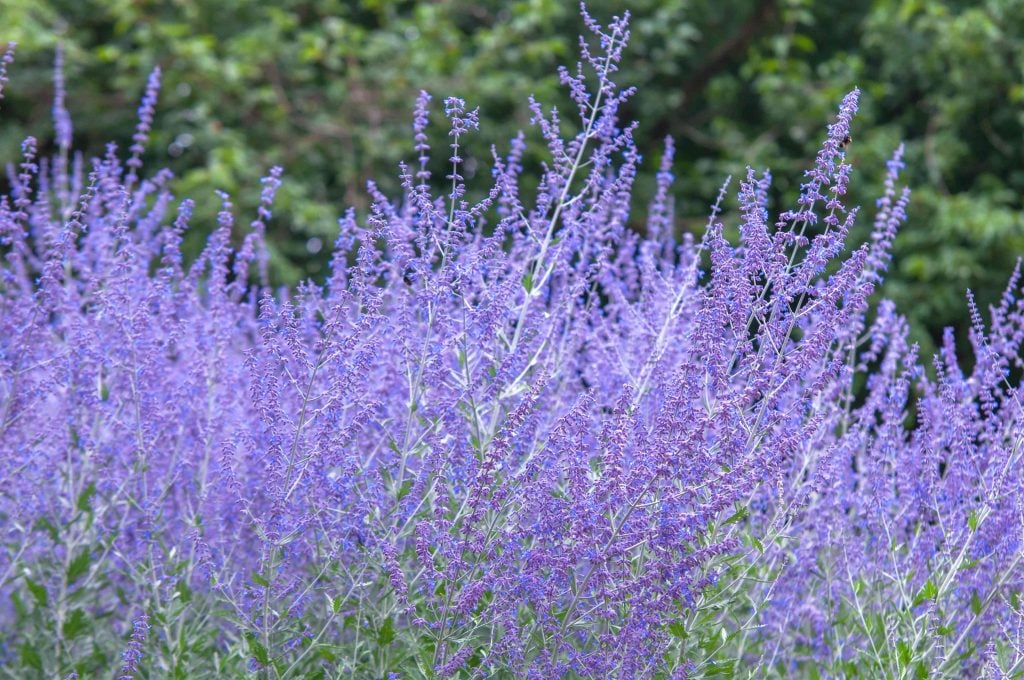
Russian Sage is an indigenous flower of Central Asia and is predominantly cultivated for its aromatic leaves and striking lavender-blue blossoms. This plant species exhibits tolerance to drought and needs moderate watering once established.
Scientific name: Perovskia Atriplicifolia
Advantages
- Russian Sage is a low-maintenance plant species that display resistance to pest and diseases, making it a prime alternative for garden enthusiasts who prefer low-maintenance choices.
- The plant’s redolent leaves and splendid flowers make a striking impression on garden borders, while its endurance in dry and poor soils permits its utilisation in various garden settings such as xeriscapes.
17. Blue Star
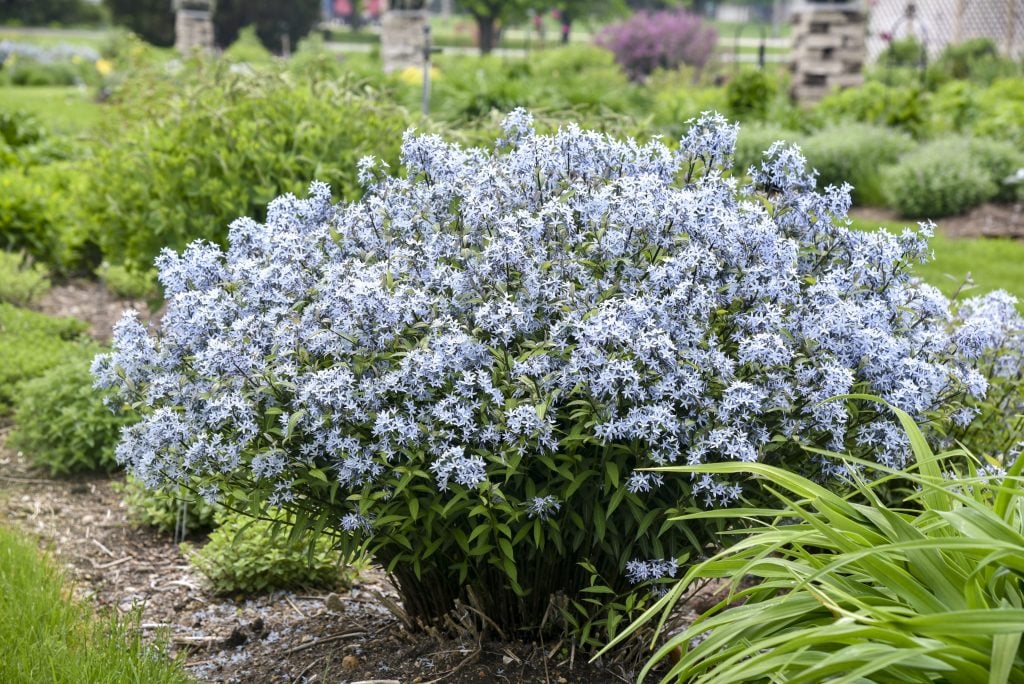
Blue Star is a herbaceous perennial plant species indigenous to North America. It is primarily cultivated for its blue-green leaves and dainty blue star-shaped flowers. These blue flowers need full sunlight to partial shade and consistent watering but can withstand certain drought conditions.
Scientific name: Amsonia Tabernaemontana
Advantages
- Blue Star is a low-upkeep plant species that is easy to cultivate and endure various soil conditions. These things make this blue flower an adaptable addition to a garden.
- Furthermore, Blue Star is resistant to deer, rendering it a fine choice for gardeners grappling with browsing deer complications.
18. Blue Flase Indigo
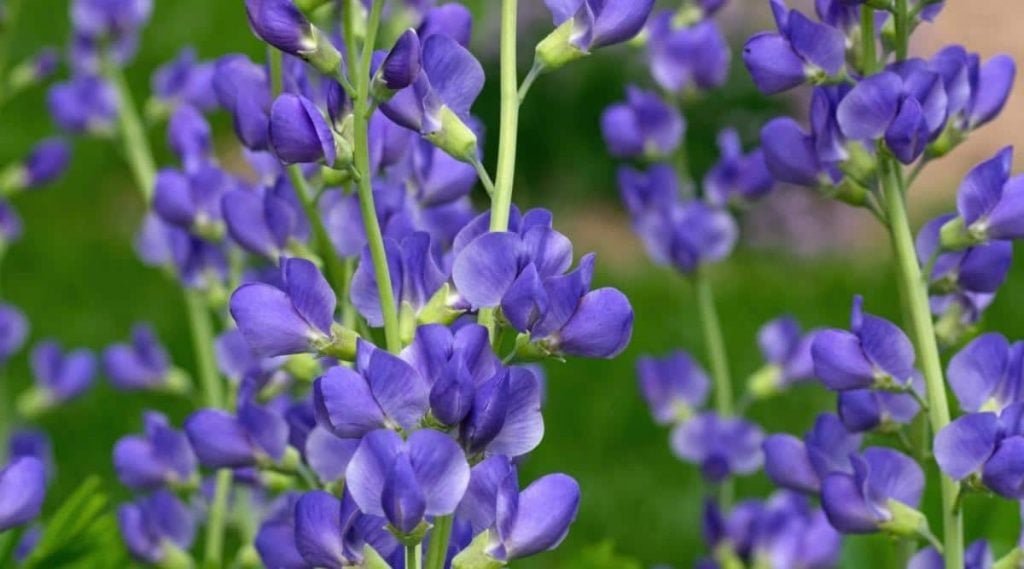
Blue Flase Indigo is a perennial plant indigenous to North America. It is cultivated for its appealing blue-green foliage and striking spikes for indigo-blue flowers. It flourishes in well-draining soil with a neutral to slightly acidic pH level.
Scientific name: Baptisia Australis
Advantages
- The Blue False Indigo is a highly adaptive plant that requires minimal care and can thrive under various soil compositions and lighting setups. This feature makes it a versatile option for adding an elegant touch to a garden or landscape.
- The plant’s striking flowers are not just visually appealing but also serve as an alluring treat for pollinators like bees and butterflies, thereby aiding in the development of local ecosystems and supporting biodiversity.
19. Blue Verbena
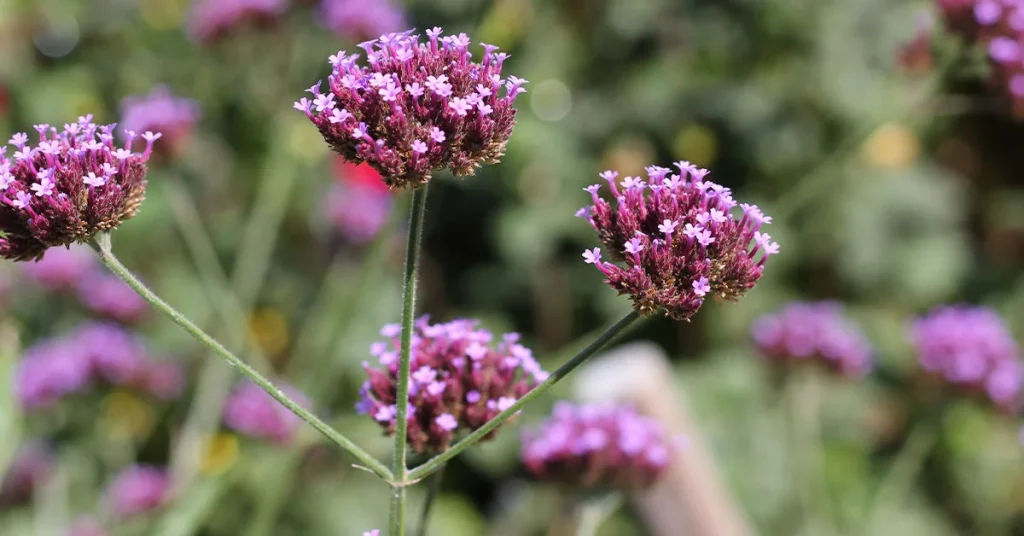
The Blue Verbena is a herbaceous perennial species that naturally occurs in North America, valued for its charming clusters of dainty blue-violet blossoms. This plant can survive in a spectrum of soil types, including sandy, loamy, and clay soils. The Blue Verbena prefers full exposure to sunlight or partial shade and needs consistent hydration to thrive.
Scientific name: Verbena Hastata
Advantages
- The Blue Verbena is a plant that requires minimal maintenance and has a broad tolerance to varying soil and lighting conditions, making it an adaptable inclusion to any garden or landscape.
- Moreover, the Blue Verbena is a deer-resistant flower that is useful in different garden settings like meadows and wildflower gardens to furnish natural beauty and an assortment of colours.
20. Blue Salvia
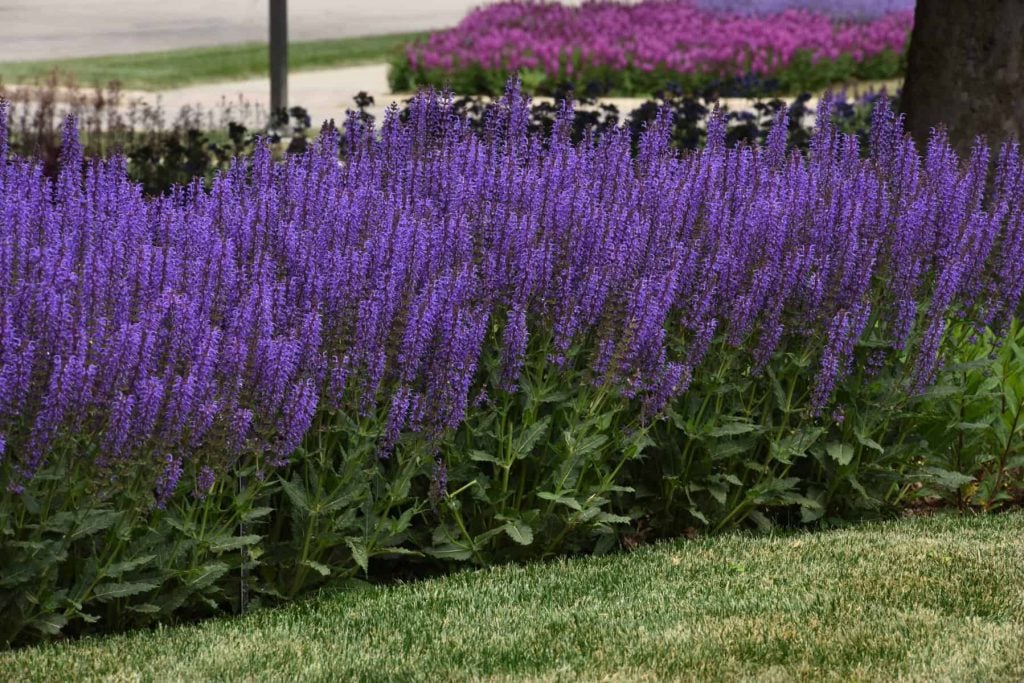
The Blue Salvias is a captivating plant that is indigenous to North and Central America, grown primarily for its attractive spikes of blue-purple flowers. This species of plant thrives in soils that are well-drained and have a neutral to slightly alkaline pH. To reach its full potential, Blue Salvia requires an abundance of sunlight or partial shade.
Scientific name: Salvia Farinacea
Advantages
- In addition to being an aesthetically pleasing plant, certain types of Blue Salvia are also recognised for their medicinal properties. Historically, these varieties have been utilised to treat a wide range of ailments, adding to the plant’s cultural and practical significance.
- Blue Salvias is a herbaceous flowering plant that is impervious to deer and can be integrated into a multitude of horticultural scenarios such as borders, rock gardens, and containers.
21. Bluebell Creeper
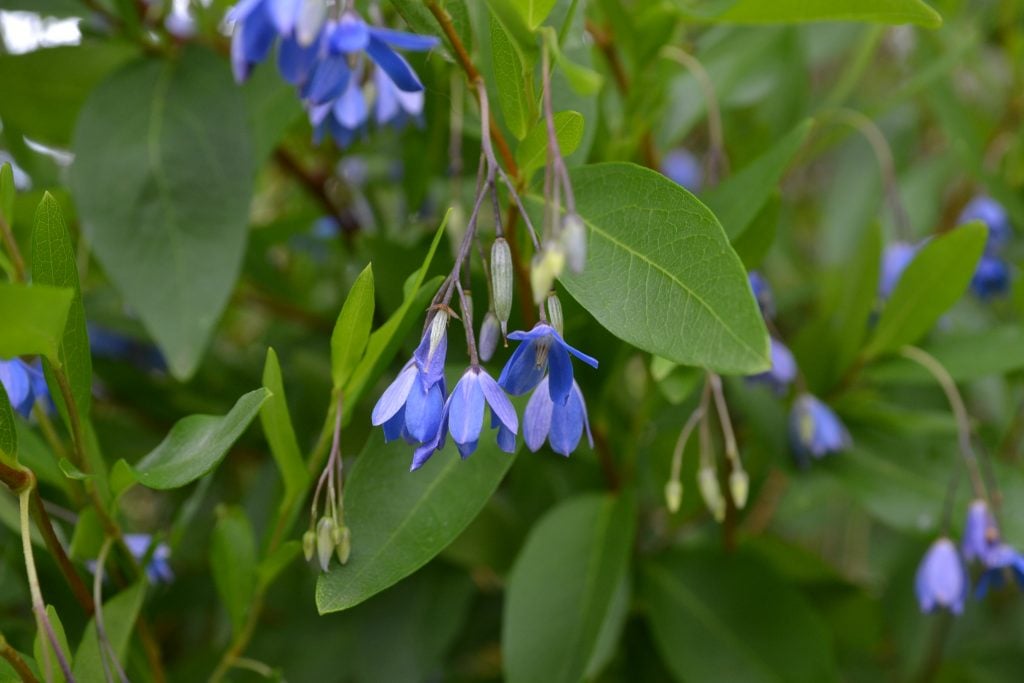
Bluebell Creeper is a perennial climbing plant that is indigenous to Australia and is cultivated for its aesthetically pleasing, blue, bell-shaped blooms. It thrives in soils that are well-drained and needs exposure to a minimum of partial sunlight to grow its full potential, along with moderate levels of hydration.
Scientific name: Sollya heterophylla
Advantages
- Bluebell Creeper needs low-maintenance plant species that solely require a moderate amount of water and can endure and adjust to various soil compositions and lighting environments.
- Additionally, it is resistant to pest infestations and plant diseases.
Basic Maintenance Tips for Your Blue Flower Plants
- Choose a good location: Blue flowers thrive best in extreme sunlight, so it is best to choose a place where they are able to get at least get six hours a day of sunlight every day.
- Prepare the soil: Most blue flowers survive best in well-draining, moist soil. Generally, the soil pH level should be between 5.5 to 6. However, some plants can sustain 7 as well.
- Water them regularly: It’s important to remember if they thrive best in full sunlight, they will surely need regular watering. However, avoid excess watering, as it may lead to root rot.
- Pruning: Regular pruning not only help the plant to have better airflow and better appeal, but it also helps them promote growth and flower production capacity.
- Avoid pests and diseases: Make sure your plants are not eaten by some insects or have any allergies or diseases. If you notice any of these issues, don’t forget to put some insecticides or pesticides.
Summing It Up
This article comprises basic maintenance pointers to facilitate the cultivation of blue-hued flowers in a garden, as well as presenting the top 21 amazing blue flowers that possess both medicinal and decorative applications. These blue flowerscan thrive in both sunny and shady environments, thereby diminishing the efforts necessary for their maintenance. This article helps you for selecting an optimum location that receives at least six hours of daylight while preparing properly drained and moist soil.
Consistent irrigation is imperative to nurture the growth and flower-bearing potential of these blue flowers. Pruning for adequate airflow and disease prevention is also highly recommended.
Additionally, this article emphasises avoiding pest infestations and plant diseases to sustain the health and vitality of these exquisite flowers.

